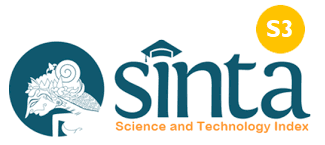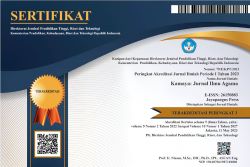Sayembara Misuhi Pandemi: Wujud Katarsis dalam Kreativitas Kebahasaan di Tengah Gelombang Pandemi Covid-19
DOI:
https://doi.org/10.37329/kamaya.v8i2.3912Keywords:
pisuhan, pandemi covid-19, bentuk, makna, faktorAbstract
This study examines the variations in Javanese swear words created in a competition titled "Sayembara Misuhi Pandemi" initiated by the Jawasastra Community. Furthermore, this study aims to examine the meaning and factors behind the emergence of these curses. The data in this study were taken from video posts on Instagram using the hashtag #misuhipandemi, which was used to identify participants in the "Misuhi Pandemic" competition. Next, the data were classified based on their linguistic markers. Data analysis was conducted using semantic descriptions of the lingual markers in the form of words and describing the sentence contexts within the curses to understand the meaning and factors behind their emergence. The analysis results show that the uniqueness of this competition is reflected in the variety of curse words directed at the COVID-19 pandemic. The curse words that emerged as curses regarding the COVID-19 pandemic are associated with nouns, verbs, and adjectives or states. When examined by factors, swearing during the COVID-19 pandemic is caused by boredom from prolonged periods at home, anger due to limited interaction with others, anger due to economic factors, and anger at society's indifference during the COVID-19 pandemic.
References
Culpeper, J. (2011). Impoliteness: Using Language to Cause Offence. Cambridge: Cambridge University Press.
Daly, H. L. (2018). On Insults. Journal of the American Philosophical Association, 4(4), 510–524.
Finn, E. (2017). Swearing: The Good, the Bad & the Ugly. ORTESOL Journal, 34, 17–26.
Freud, S., & Strachey, J. (2004). Totem and Taboo: Some Points of Agreement Between the Mental Lives of Savages and Neurotics. Taylor & Francis e-Library.
Jay, T. (2009). The Utility and Ubiquity of Taboo Words. Perspectives on Psychological Science, 4(2), 153–161.
Jay, T., & Janschewitz, K. (2008). The Pragmatics of Swearing. Journal of Politeness Research: Language, Behaviour, Culture, 4(2).
Poedjosoedarmo, S. (1968). Javanese Speech Levels. Indonesia, 6, 54–81.
Poedjosoedarmo, S. (2017). Language Propriety in Javanese. Journal of Language and Literature, 17(1).
Sholihatin, E. (2013). Apakah Pisuhan Selalu Bermakna Negatif?: Fungsi Pisuhan dalam Masyarakat Arek dan Masyarakat Mataraman. Mozaik, 13(2), 158–167.
Sudarmaningtyas, A. E. R. (2020). Plesetan Pisuhan Bahasa Jawa dalam Strategi Peningkatan Identitas dan Etika Komunikasi pada Masyarakat Jawa. UNEJ e-Proceeding, 320–331.
Wijana, I. D. P. (2008). Kata-Kata Kasar dalam Bahasa Jawa. Humaniora, 20(3), 249–256.
Wijana, I. D. P. (2015). Pengantar Semantik Bahasa Indonesia (Cetakan II). Yogyakarta: Program Studi S2 Linguistik, Fakultas Ilmu Budaya, Universitas Gadjah Mada.
Wijayanti, K. D. (2014). Bentuk dan Fungsi Pisuhan Bahasa Jawa: Suatu Kajian Sosiopragmatik. Proceedings International Seminar Language Maintenance and Shift IV
Downloads
Published
How to Cite
Issue
Section
License
Copyright (c) 2025 Kamaya: Jurnal Ilmu Agama

This work is licensed under a Creative Commons Attribution-ShareAlike 4.0 International License.
An author who publishes in the Kamaya : Jurnal Ilmu Agama agrees to the following terms:
- Author retains the copyright and grants the journal the right of first publication of the work simultaneously licensed under the Creative Commons Attribution-ShareAlike 4.0 License that allows others to share the work with an acknowledgement of the work's authorship and initial publication in this journal
- Author is able to enter into separate, additional contractual arrangements for the non-exclusive distribution of the journal's published version of the work (e.g., post it to an institutional repository or publish it in a book) with the acknowledgement of its initial publication in this journal.
- Author is permitted and encouraged to post his/her work online (e.g., in institutional repositories or on their website) prior to and during the submission process, as it can lead to productive exchanges, as well as earlier and greater citation of the published work (See The Effect of Open Access).
Read more about the Creative Commons Attribution-ShareAlike 4.0 Licence here: https://creativecommons.org/licenses/by-sa/4.0/.





